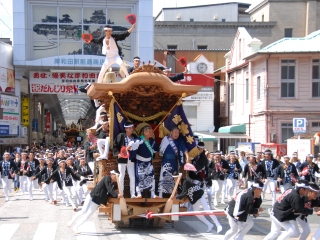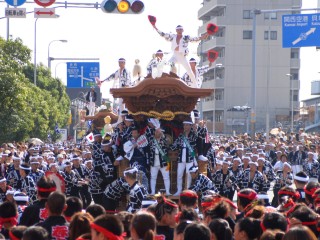
The easiest way to penetrate to the essence of Japanese culture is to go out into the countryside and witness Japan’s traditional festivals, or matsuri .
On festival days the residents of the area turn out to sing and dance and play traditional matsuri music while a bunch of inebriated men parade through the streets carrying a mikoshi , a portable Shinto shrine. There are endless local variations on this basic theme, some of them are quite surprising. In certain locales you might see mikoshi ramming into one another in the middle of the night, or people with mud slathered all over their bodies, or men clothed only in loin cloths scrambling furiously for some wooden charms. The fact that these events have been known to result in serious injuries, and even the occasional fatality, seems to give no one pause.
A Time to Let Loose
Matsuri are a special time when people of all types, young and old, male and female, kick up their heels in happy celebration. Yet almost none of these people have the slightest knowledge of the festival’s or the origin of the deity being honored. As for the underlying Shintô doctrines, no one would be so gauche as to inquire about such a thing.
That is as it should be. In the spring, before the planting begins, the people summon the god down from the mountain to grant them a bumper crop. In the autumn, when the harvest was over, they give thanks and sent the god back up the mountain. These are by nature joyous occasions, and that is the reason people traditionally sing and dance and make merry. All other days of the year are dedicated to the conscientious completion of routine tasks and duties, but during matsuri , everyone is allowed to cut loose.
Traditionally, all the residents of the area, no matter how they made their living, joined willingly in the busy preparations that began many days before the actual matsuri . After hours you could find them re-thatching the roofs of the shrine buildings, crafting ceremonial objects, or mending and altering the clothes worn by priests and dancers. At home families made unrefined sake, pounded rice into mochi cakes, and prepared festive local dishes. In the process, traditional skills preserved for many generations were passed down from parent to child.
As the matsuri approached, people for whom hard work and fatigue were a way of life were suddenly full vim and vigor. Young men brimmed with nervous anticipation, each planning how he would take advantage of the commotion to let that special girl how he felt. The young women, for their part, looked forward to a rare opportunity to dress up. What fun the matsuri was!
The Death of Matsuri

Alas, in today’s Japan the matsuri is on the verge of extinction. A superficial individualism has taken hold throughout the nation, the bonds of community are frayed, families are scattered. In many communities, no one even bothers to turn out on festival day. So, a handful of volunteers load the mikoshi on the back of a truck and, with the cooperation of the local police, drive it around the town with a loud speaker blaring festival music. Once around, and the matsuri is over.
In these communities the matsuri is dead. And gone with it are a rich spiritual heritage, an array of traditional crafts, and the warm community ties that once bound people together.
Neither the 2008 financial meltdown nor the strong yen is to blame for Japan’s lackluster economy. The problem is that the Japanese people no longer have the enthusiasm required to dispel those dark clouds.
This is why I am calling for the recreation of the matsuri . I do not mean the revival of the festivals of old—those are a thing of the past. What we need to do is recreate the matsuri in a new form, as something that can stir the souls of the Japanese people today. We need a special day when everyone is allowed to dance about in ecstasy and simply rejoice in life. For that to happen, the new matsuri must be something that all the people of the area can enjoy, be they shop owners, tradespeople, or office workers transferred there from afar.
It is common psychiatric knowledge that suppressed emotion can build up and lead to psychosomatic disorders. A festival must have the exuberance and brio sufficient to liberate all our pent-up emotions in one outburst.
When such events reemerge all around Japan, the economy will come back to life, and the ranks of the depressed and suicidal will dwindle. Japan has blossomed along with its matsuri , and it will do so again.
